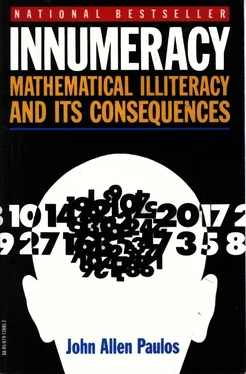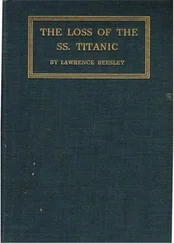People don't generally appreciate how large such seemingly tidy collections can be. A sports-writer once recommended in print that a baseball manager should play every possible combination of his twenty-five-member team for one game to find the nine that play best together. There are various ways to interpret this suggestion, but in all of them the number of games is so large that the players would be long dead before the games were completed.
TRIPLE-SCOOP CONES AND VON NEUMANN'S TRICK
Baskin-Robbins ice-cream parlors advertise thirty-one different flavors of ice cream. The number of possible triple-scoop cones without any repetition of flavors is therefore 31 x 30 x 29 = 26,970; any of the thirty-one flavors can be on top, any of the remaining thirty in the middle, and any of the remaining twenty-nine on the bottom. If we're not interested in how the flavors are arranged on the cone but merely in how many three-flavored cones there are, we divide 26,970 by 6, to get 4,495 cones. The reason we divide by 6 is that there are 6 = 3x2 x 1 different ways to arrange the three flavors in, say, a strawberry-vanilla-chocolate cone: SVC, SCV, VSC, VCS, CVS, and CSV. Since the same can be said for any three-flavored cone, the number of such cones is (31 x 30 x 29)/(3 x 2 x 1) = 4,495.
A less fattening example is provided by the many state lotteries which require the winner to choose six numbers out of a possible forty. If we're concerned with the order in which these six numbers are chosen, then there are (40 x 39 x 38 x 37 x 36 x 35) = 2,763,633,600 ways of choosing them. If, however, we are interested only in the six numbers as a collection (as we are in the case of the lotteries) and not in the order in which they are chosen, then we divide 2,763,633,600 by 720 to determine the number of such collections: 3,838,380. The division is necessary since there are 720 = 6 x 5x4x3x2x1 ways to arrange the six numbers in any collection.
Another example, and one of considerable importance to card players, is the number of possible five-card poker hands. There are 52 x 51 x 50 x 49 x 48 possible ways to be dealt five cards if the order of the cards dealt is relevant. Since it's not, we divide the product by (5 x 4 x 3 x 2 x 1), and find that there are 2,598,960 possible hands. Once that number is known, several useful probabilities can be computed. The chances of being dealt four aces, for example, is 48/2,598,960 (= about 1 in 50,000), since there are forty-eight possible ways of being dealt a hand with four aces corresponding to the forty-eight cards which could be the fifth card in such a hand.
Note that the form of the number obtained is the same in all three examples: (32 x 30 x 29)/ (3x2x1) different three-flavored ice-cream cones; (40 x 39 x 38 x 37 x 36 x 35)/(6 x 5 x 4 x 3 x 2 x 1) different ways to choose six numbers out of forty; and (52 x 51 x 50 x 49 x 48)/(5 x 4 x 3x2x1) different poker hands. Numbers obtained in this way are called combinatorial coefficients. They arise when we're interested in the number of ways of choosing R elements out of N elements and we're not interested in the order of the R elements chosen.
An analogue of the multiplication principle can be used to calculate probabilities. If two events are independent in the sense that the outcome of one event has no influence on the outcome of the other, then the probability that they both occur is computed by multiplying the probabilities of the individual events.
For example, the probability of obtaining two heads in two flips of a coin is 1/ 2x 1/ 2 = 1/ 4since of the four equally likely possibilities-tail,tail; tail,head; head,tail; head,head-one is a pair of heads. For the same reason, the probability of five straight coin flips resulting in heads is ( 1/ 2) 5= 1/ 32since one of the thirty-two equally likely possibilities is five consecutive heads.
Since the probability that a roulette wheel will stop on red is 18/ 38, and since spins of a roulette wheel are independent, the probability the wheel will stop on red for five consecutive spins is ( 18/ 38) 5(or.024 -2.4%). Similarly, given that the probability that someone chosen at random was not born in July is 11/ 12 , and given that people's birthdays are independent, the probability that none of twelve randomly selected people was born in July is ( 11/ 12) 12(or.352 – 35.2%). Independence of events is a very important notion in probability, and when it holds, the multiplication principle considerably simplifies our calculations.
One of the earliest problems in probability was suggested to the French mathematician and philosopher Pascal by the gambler Antoine Gombaud, Chevalier de Mere. De Mere wished to know which event was more likely: obtaining at least one 6 in four rolls of a single die, or obtaining at least one 12 in twenty-four rolls of a pair of dice. The multiplication principle for probabilities is sufficient to determine the answer if we remember that the probability that an event doesn't occur is equal to 1 minus the probability that it does (a 20 percent chance of rain implies an 80 percent chance of no rain).
Since 5/ 6is the probability of not rolling a 6 on a single roll of a die, ( 5/ 6) 4is the probability of not rolling a 6 in four rolls of the die. Hence, subtracting this number from 1 gives us the probability that this latter event (no 6s) doesn't occur; in other words, of there being at least one 6 rolled in the four tries: 1 – ( 5/ 6) 4=.52. Likewise, the probability of rolling at least one 12 in twenty-four rolls of a pair of dice is seen to be 1 – ( 35/ 36) 24=.49.
A more contemporary instance of the same sort of calculation involves the likelihood of acquiring AIDS heterosexually. It's estimated that the chance of contracting AIDS in a single unprotected heterosexual episode from a partner known to have the disease is about one in five hundred (the average of the figures from a number of studies). Thus, the probability of not getting it from a single such encounter is 499/500. If these risks are independent, as many assume them to be, then the chances of not falling victim after two such encounters is (499/500) 2, and after N such encounters (499/500) N. Since (499/ 500) 346is 1/ 2one runs about a 50 percent chance of not contracting AIDS by having unsafe heterosexual intercourse every day for a year with someone who has the disease (and thus, equivalently, a 50 percent chance of contracting it).
With a condom the risk of being infected from a single unsafe heterosexual episode with someone known to have the disease falls to one in five thousand, and safe sex every day for ten years with such a person (assuming the victim's survival) would lead to a 50 percent chance of getting the disease yourself. If your partner's disease status is not known, but he or she is not a member of any known risk group, the chance per episode of contracting the infection is one in five million unprotected, one in fifty million with a condom. You're more likely to die in a car crash on the way home from such a tryst.
Two opposing parties often decide an outcome by the flip of a coin. One or both of the parties may suspect the coin is biased. A cute little trick utilizing the multiplication principle was devised by mathematician John von Neumann to allow the contestants to use the biased coin and still get fair results.
The coin is flipped twice. If it comes up heads both times or tails both times, it is flipped twice again. If it comes up heads-tails, this will decide the outcome in favor of the first party, and if it comes up tails-heads, this will decide the outcome in favor of the second party. The probabilities of both these outcomes are the same even if the coin is biased. For example, if the coin lands heads 60 percent of the time and tails 40 percent of the time, a heads-tails sequence has probability.6 x.4 =.24 and a tails-heads sequence has probability.4 x.6 =.24. Thus, both parties can be confident of the fairness of the outcome despite the possible bias of the coin (unless it is crooked in some different way).
Читать дальше












